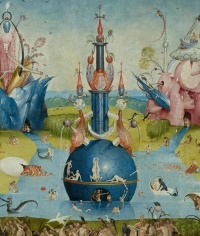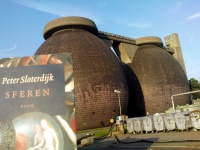Spheres (Peter Sloterdijk)
From The Art and Popular Culture Encyclopedia
.JPG)
|
"The difficulty that had to be overcome (…) was to avoid all geometrical evidence. In other words, I had to start with a sort of intimacy of roundness." --The Poetics of Space (1958) by Gaston Bachelard "Only a few Heidegger exegetes seem to have realized that the sensational programmatic tide of Sein und Zeit also contains an embryonically revolutionary treatise on being and space. […] The present project, Spheres, can also be understood as an attempt to recover-in -one substantial aspect, at least-the project wedged sub-thematically into Heidegger's early work, namely Being and Space, from its state of entombment."--Spheres (1998, 1999, 2004) by Peter Sloterdijk "One remembers that there was a second inscription above the entrance to the academy, occult and humorous, stating that whoever was unwilling to become entangled in love affairs with other visitors in the garden of theory should keep away."--Spheres (1998, 1999, 2004) by Peter Sloterdijk "Let us explain this key difference via a detour through Peter Sloterdijk. The basic idea of Sloterdijk’s notion of “spheres” is that, since humans are prematurely born and cannot survive being directly thrown into the openness of the world, they have to build different forms of spheres, self-enclosed protective environments that provide some kind of shelter, real or imagined, against the threats of external reality. Genetically, the zero-point “sphere” is, of course, the biological and utopian comfort of the mother’s womb, which humans try to recreate through science, ideology, and religion."--Sex and the Failed Absolute (2019) by Slavoj Žižek See philosophy of space, bubble, circle, foam, globe, sphere. |

|
Related e |
|
Featured: |
The Spheres trilogy (consisting of Bubbles, Globes, and Foam) is a series of books by German philospher Peter Sloterdijk, often considered his magnum opus. The first volume was published in 1998, the second in 1999 and the last in 2004. It is a Bachelardian exploration of the philosophy of space.
Spheres is about spaces of coexistence, spaces which are commonly overlooked or taken for granted and conceal information crucial to developing an understanding of what humans are. The exploration of these spheres begins with the basic difference between mammals and other animals: the biological and utopian comfort of the mother's womb, which humans try to recreate through science, ideology, and religion. From these microspheres (ontological relations such as fetus-placenta) to macrospheres (macro-uteri such as political structures like nations or states), Sloterdijk analyses the spheres where humans unsuccessfully try to dwell and traces a connection between vital crisis (e.g. emptiness and narcissistic detachment) and the crises that are created when a Sphere shatters.
The author has said that the first paragraphs of Spheres are “the book that Heidegger should have written," a companion volume to Being and Time, namely, "Being and Space". He was referring to his initial exploration of the idea of Dasein, which is then taken further as Sloterdijk distances himself from Heidegger’s positions.
Semiotext(e) blurb
- An epic project in both size and purview, Peter Sloterdijk's three-volume, 2,500-page Spheres is the late-twentieth-century bookend to Heidegger's Being and Time. Rejecting the century's predominant philosophical focus on temporality, Sloterdijk, a self-described "student of the air," reinterprets the history of Western metaphysics as an inherently spatial and immunological project, from the discovery of self (bubble) to the exploration of world (globe) to the poetics of plurality (foam). Exploring macro- and micro-space from the Greek agora to the contemporary urban apartment, Sloterdijk is able to synthesize, with immense erudition, the spatial theories of Aristotle, René Descartes, Gaston Bachelard, Walter Benjamin, and Georges Bataille into a morphology of shared, or multipolar, dwelling--identifying the question of being as one bound up with the aerial technology of architectonics and anthropogenesis.Sloterdijk describes Bubbles, the first volume of Spheres, as a general theory of the structures that allow couplings--or as the book's original intended subtitle put it, an "archeology of the intimate." Bubbles includes a wide array of images, not to illustrate Sloterdijk's discourse, but to offer a spatial and visual "parallel narrative" to his exploration of bubbles.Written over the course of a decade, the Spheres trilogy has waited another decade for its much-anticipated English translation from Semiotext(e). Volumes II, Globes, and III, Foam, will be published in the coming seasons.
Full text of volume I[1]
See also

_.jpg)

